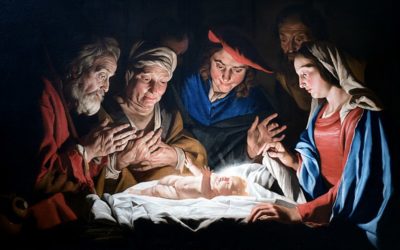Historical Background
The publication of the Book of Mormon, the movement of the Saints from New York, and the gathering of the Saints to Ohio attracted newspaper attention and generated hosts of rumors, many of them negative. While battling these rumors, Church members were also eager for further light and knowledge on the Second Coming of the Lord and the gathering of the Saints in preparation for that day. On March 7, 1831, at Kirtland, Joseph received a revelation that provided rich insights for the members. It is now known as section 45 of the Doctrine and Covenants.
For more historical information on this section, click here.
Hearken and Come to the Savior
In the revelation, the Savior calls on the “people of my church, to whom the kingdom has been given” to listen and obey (verse 1). He also recounts details of His life and death, as though He is introducing Himself to his people.
He is “the advocate with the Father, who is pleading your cause before him—saying: Father, behold the sufferings and death of him who did no sin, in whom thou wast well pleased; behold the blood of thy Son which was shed, the blood of him whom thou gavest that thyself might be glorified. Wherefore, Father, spare these my brethren that believe on my name, that they may come unto me and have everlasting life.” (Verses 3‒5.)
The terminology the Lord used to introduce Himself would have been familiar to this Bible-literate audience: “I am Alpha and Omega, the beginning and the end, the light and the life of the world—a light that shineth in darkness and the darkness comprehendeth it not. I came unto mine own, and mine own received me not; but unto as many as received me gave I power to do many miracles, and to become the sons of God; and even unto them that believed on my name gave I power to obtain eternal life.” (Verses 7‒8).
The Lord then extends an invitation to His followers, explaining the Restoration and inviting them to be part of it: “I have sent mine everlasting covenant into the world, to be a light to the world, and to be a standard for my people, and for the Gentiles to seek to it, and to be a messenger before my face to prepare the way before me. Wherefore, come ye unto it, and with him that cometh I will reason as with men in days of old, and I will show unto you my strong reasoning.” (Verses 9‒10.)
Enoch and His City of Zion
Under Joseph Smith’s guidance, the Saints had been preparing to build a new city of Zion, the new Jerusalem, and the Lord reflected back on Enoch and his city. “Wherefore,” the Savior said to the modern Saints, “hearken ye together and let me show unto you even my wisdom—the wisdom of him whom ye say is the God of Enoch, and his brethren, who were separated from the earth, and were received unto myself—a city reserved until a day of righteousness shall come—a day which was sought for by all holy men, and they found it not because of wickedness and abominations; and confessed they were strangers and pilgrims on the earth; but obtained a promise that they should find it and see it in their flesh.” (Verses 11‒14.)
The Temple at Jerusalem
With the Saints in the last days hoping to build the new Jerusalem, interest in the original Mideast Jerusalem and the Savior’s prophecies of His Second Coming were of great interest in 1831, as they are today. Section 45 invited readers and listeners to hear the Lord recount what He said to His disciples in the meridian of time about this subject, with particular focus on what would happen in the last days.
“Wherefore, hearken and I will reason with you, and I will speak unto you and prophesy, as unto men in days of old,” the Lord said to the latter-day Saints. “And I will show it plainly as I showed it unto my disciples as I stood before them in the flesh, and spake unto them, saying: As ye have asked of me concerning the signs of my coming, in the day when I shall come in my glory in the clouds of heaven, to fulfil the promises that I have made unto your fathers, for as ye have looked upon the long absence of your spirits from your bodies to be a bondage, I will show unto you how the day of redemption shall come, and also the restoration of the scattered Israel.” (Verses 15‒17.)
“And now,” he said, as though they were with Him two millennia earlier, “ye behold this temple which is in Jerusalem, which ye call the house of God, and your enemies say that this house shall never fall.1 But, verily I say unto you, that desolation shall come upon this generation as a thief in the night, and this people shall be destroyed and scattered among all nations. And this temple which ye now see shall be thrown down that there shall not be left one stone upon another. And it shall come to pass, that this generation of Jews shall not pass away until every desolation which I have told you concerning them shall come to pass.” (Verses 18‒21.)
The next verses explain that before the end of the world, the scattered remnant of Israel will be gathered again when “the times of the Gentiles be fulfilled” (verses 22‒25).
The Times of the Gentiles
The Lord then recounts what will happen “in that day,” an explanation that would have seemed very pertinent to the Saints who were gathering in Ohio. The Lord said there “shall be heard of wars and rumors of wars, and the whole earth shall be in commotion, and men’s hearts shall fail them, and they shall say that Christ delayeth his coming until the end of the earth” (verse 26). These were just some of the signs of the times. There were others: “the love of men shall wax cold, and iniquity shall abound” (verse 27). The Saints in Ohio would have recognized all these signs.
“And when the times of the Gentiles is come in,” the Lord said, a light shall break forth among them that sit in darkness, and it shall be the fulness of my gospel” (verse 28). The gathered Saints in Ohio would have understood this breaking light to be the gospel they had received by joining the Church. But the Lord explained that not everyone would receive it, “for they perceive not the light, and they turn their hearts from me because of the precepts of men” (verse 29).
As the times of the Gentiles were being fulfilled, people would experience “an overflowing scourge; for a desolating sickness shall cover the land’ (verses 30‒31). “My disciples shall stand in holy places, and shall not be moved,” the Savior told the Saints, “but among the wicked, men shall lift up their voices and curse God and die” (verse 32).
While all this was going on, there would be “earthquakes also in divers places, and many desolations” (verse 33). Some would reject the gospel, hardening their hearts and taking up “the sword, one against another,” killing each other (verse 34). When these things occurred, He told his disciples, they would know that the time of the Lord’s coming was nigh (verses 35‒38).
Signs of the Coming of the Son of Man
When it was time for “for the great day of the Lord to come, the disciples would “see signs and wonders, . . . in the heavens above, and in the earth beneath,” including “blood, and fire, and vapors of smoke” (verses 39‒41). Before the Lord’s arrival, “the sun shall be darkened, and the moon be turned into blood, and the stars fall from heaven” (verse 42).
Another sign would be that “the remnant shall be gathered” (verse 43). The Saints in 1831 would have realized this verse included them. “And then they shall look for me, and, behold, I will come; and they shall see me in the clouds of heaven, clothed with power and great glory; with all the holy angels; and he that watches not for me shall be cut off” (verse 44).
When the Lord comes, “the saints that have slept shall come forth to meet me in the cloud” (verse 45). Then the Lord’s arm would “fall upon the nations” (verse 47). “And then shall the Lord set his foot upon this mount, and it shall cleave in twain, and the earth shall tremble, and reel to and fro, and the heavens also shall shake” (verse 48).
The wicked would then be destroyed, and the Jews would recognize Him as their King (verses 49‒53).
The Millennial Reign of Christ
The Millennium would then follow. Satan would “be bound” (verse 55). The righteous would “abide the day” (verse 57) and receive the earth “for an inheritance” (verse 58). “For the Lord shall be in their midst, and his glory shall be upon them, and he will be their king and their lawgiver” (verse 59).
The New Translation to Reveal More
Since much of this revelation was a commentary or expansion of a Matthew 24 in the New Testament, the Lord told Joseph , “it shall not be given unto you to know any further concerning this chapter, until the New Testament be translated, and in it all these things shall be made known” (verse 60). Joseph had been translating the Old Testament but was told “ye may now translate” the New Tesatment, “that ye may be prepared for the things to come” (verse 61). “For verily I say unto you, that great things await you” (verse 62).
Gather and Build the New Jerusalem
One of the signs that would precede the Lord’s coming was wars and rumors of wars. In section 45, the Lord pointed out that although “ye hear of wars in foreign lands . . . not many years hence ye shall hear of wars in your own lands: (verse 63), something that certainly came true with the United States Civil War.
Meanwhile, the Lord told the Saints, “gather ye out from the eastern lands, assemble ye yourselves together ye elders of my church; go ye forth into the western countries, call upon the inhabitants to repent, and inasmuch as they do repent, build up churches unto me” (verse 64). In addition to gathering themselves, the Lord commanded them, “with one heart and with one mind, gather up your riches that ye may purchase an inheritance which shall hereafter be appointed unto you” (verse 65). “And it shall be called the New Jerusalem, a land of peace, a city of refuge, a place of safety for the saints of the Most High God” (verse 66).
This New Jerusalem would be a holy city. “And the glory of the Lord shall be there, and the terror of the Lord also shall be there, insomuch that the wicked will not come unto it, and it shall be called Zion” (verse 67). People will have to flee there to be safe (verse 68). “And there shall be gathered unto it out of every nation under heaven; and it shall be the only people that shall not be at war one with another” (verse 69). The wicked would fear to battle Zion, “for the inhabitants of Zion are terrible” (verse 70). “And it shall come to pass that the righteous shall be gathered out from among all nations, and shall come to Zion, singing with songs of everlasting joy” (verse 71).
These verses gave the assembling Saints in 1831 a sense for what they were doing in gathering to Zion and building it up.
Keep These Things from Going Abroad
This revelation now known as section 45 gave great joy to the Saints. But they were to be cautious in what they said about it publicly, just as Saints are always cautioned to be wise in preserving what the Lord has shown until them. “Keep these things from going abroad unto the world until it is expedient in me,” the Lord commanded, “that ye may accomplish this work in the eyes of the people, and in the eyes of your enemies, that they may not know your works until ye have accomplished the thing which I have commanded you” (verse 72). “For when the Lord shall appear he shall be terrible unto them, that fear may seize upon them, and they shall stand afar off and tremble” (verse 74).
Many more revelations would follow. But this one in particular gave the gathering Saints a sense for what they were to do in the near future.



